1981 British Grand Prix race report - A very popular win
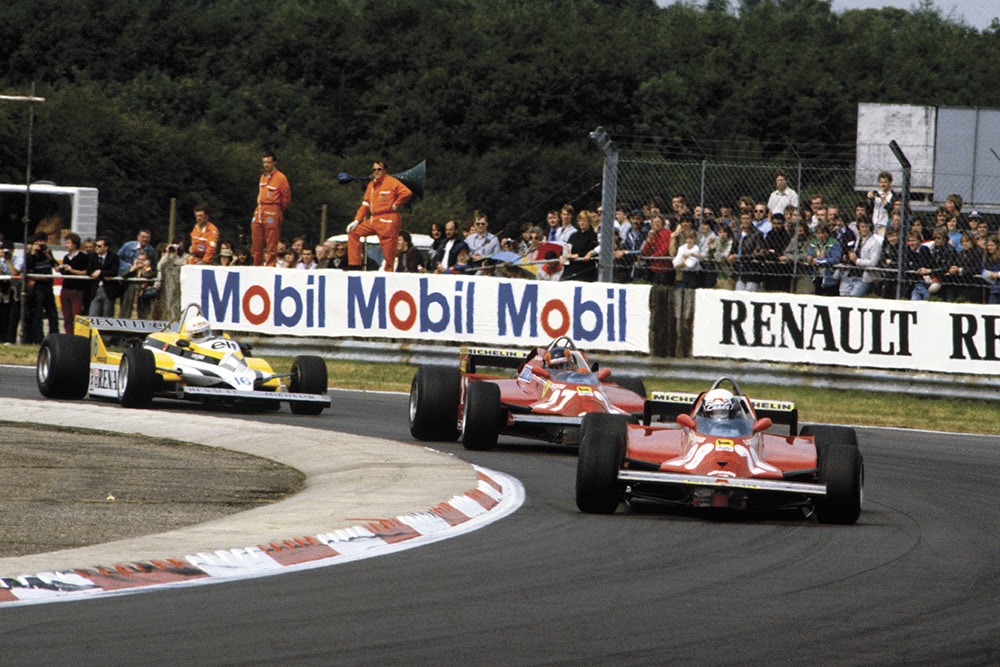
Didier Pironi leads team mate Gilles Villeneuve (both Ferrari 126CK).
© Motorsport Images
A very popular win
Silverstone, July 18th
Enormous is the only way to describe the size of the organisation behind this year’s British Grand Prix at Silverstone, backed by Marlboro and with the support of just about every racing enthusiast in the country, all master-minded by the RAC Motor Sports Association. The pits and paddock became a veritable young town, with motor homes, tents, marquees and trade vehicles as far as the eye could see, let alone all the competitors in the supporting races and all the cars in the parades. You certainly would not think that Great Britain was in the midst of a serious recession.
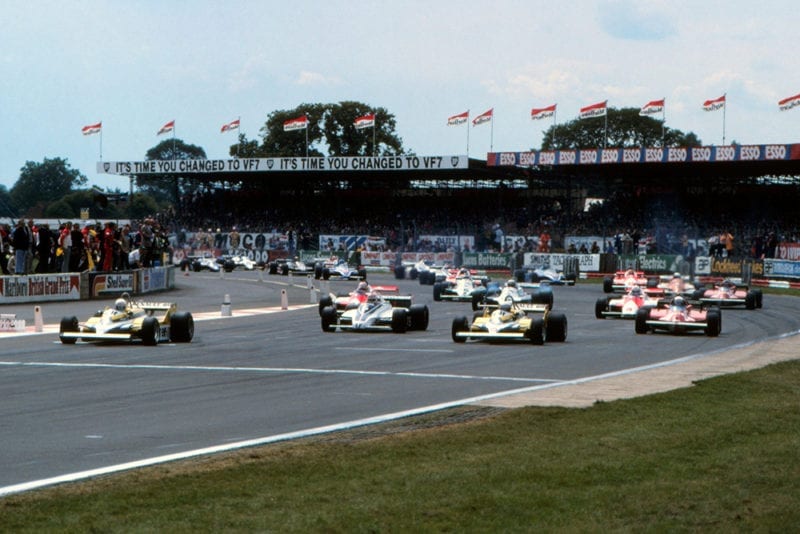
Pole sitter Rene Arnoux (Renault RE30) gets away into the lead at the start of the race.
© Motorsport Images
The Formula One cars were scrutineered on Wednesday July 15th, preparatory to starting practice at 10 a.m. on Thursday, and Team Lotus presented three Type 88B cars, the original test car and rwo brand new ones. They were passed by the RAC scrutineers, but nearly two hours later an official protest was handed in from Ferrari, Alfa Romeo and Talbot-Matra. During Thursday, while the Stewards deliberated and had discussions with the FISA representatives, the Lotuses took part in the morning test session and the afternoon timed session. The atmosphere in certain parts of the pit lane was rather like the weather, grey and cool! All this time the RAC Motor Sports Association had been standing by Team Lotus sure in the knowledge that any decisions made rested with the Stewards of the meeting. By Friday morning all the decisions had been turned through 180-degrees and the Lotus 88B was declared illegal and the times recorded by de Angelis and Mansell on Thursday afternoon were disallowed. All along the RACMSA thought that they had supreme power over their own Grand Prix, but it seems that someone read the rule-book incorrectly, as regards the running of a Grand Prix, and the FIA, through its FISA representative, can and did over-rule any decision made by the Stewards or the organisers, and the FIA/FISA deemed the Lotus 88B to be a direct derivative of the Lotus 88 which the International Court of Appeal had already declared illegal and contravening the Formula One rules. Meanwhile there are numerous rules in the book being flagrantly broken, like the simple one that says the driver’s name must appear on the bodywork of the car. You won’t find the names of Piquet or Rebaque on the Brabhams!
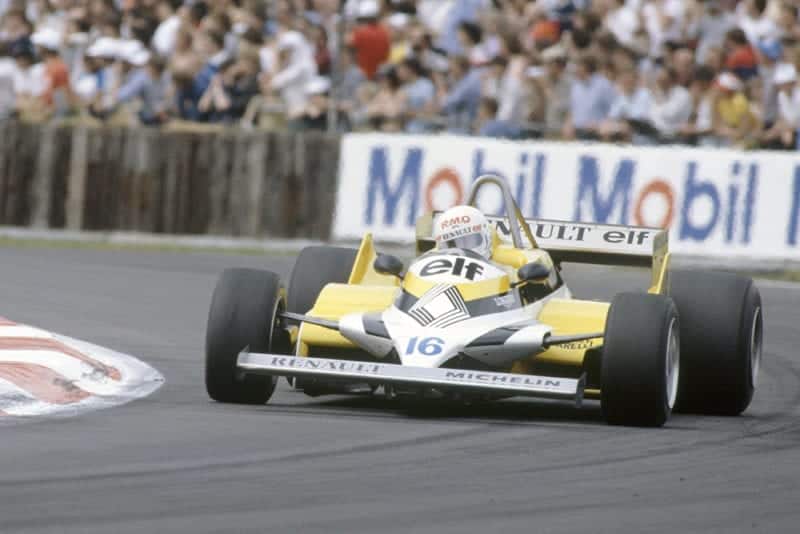
Rene Arnoux in his Renault RE30.
© Motorsport Images
The result of all this double-talk, gobbledy-gook and double-crossing was that Team Lotus had to do an enormous amount of work in a very short time, to convert the 88B cars into 87 cars, which was done by removing the aerodynamic sprung-structure·in its entirely and substituting conventional side-pods and rear aerofoil and changing all the ancillaries involved and generally re-jigging the whole car to suit a different conception; the prototype 88B/1 could not be converted so major components like engine, gearbox, rear suspension were removed and the rest abandoned in a corner of one of the garages. The two new cars, numbers two and four, were converted, and number three, which was already in 87 form was brought over from the factory. There ended the latest chapter in the saga of the Lotus 88.
For the rest of the very full entry things progressed a bit more normally, though not very smoothly for some teams. Tyrrell brought along his brand new design, designated 011/1, for Cheever to drive, but we were only halfway through the Thursday afternoon qualifying hour when he went off in a big way at the Woodcote Chicane and bent it rather badly, so it was not seen again. Cheever did the rest of the meeting in an old 010 car. The Brabham team, with Gordon Murray in charge as Mr. Ecclestone was on a “business trip” in America, tried to stretch the rules to the limit and get Piquet on pole-position using the very powerful, but fragile, turbo-charged BMW powered BT50 and then to substitute their regular Cosworth-powered BT49C in its place for the race itself.

L-R: Alan Jones (Williams FW07C) becomes a victim of the catch fencing after getting caught up in the accident of Gilles Villeneuve, (Ferrari 126CK).
© Motorsport Images
It was a nice try but it didn’t work, for the Cosworth-powered car was the faster of the two, but not fast enough to claim pole-position. Ferrari brought along an experimental car with a revised front and rear-suspension, number 051/B, and both Villeneuve and Pironi persevered with it during the two days of practice but did not make any startling progress and on Friday morning Pironi had the rear brakes lock up at Becketts Corner and spun off. The damage was superficial and the car was out again in the afternoon with Villeneuve in the cockpit. In addition Pironi used 053 and Villeneuve had a brand new car, 054, both being to normal specification. It was noticeable that the engines were running fairly low boost and were totally reliable, all the experimentation going into the suspension and handling. Among the French teams Renault were extremely happy while Talbot were in all sorts of trouble. The Renaults were very fast, very stable and handled well on Silverstone’s fast corners using new central-pillar mounted rear aerofoils for the first time and turbo-lag was not a problem with the absence of slow corners. Both Arnoux and Prost were in great form and apart from Prost’s engine expiring in a cloud of smoke at Copse on Friday afternoon they ran well. Prost took over the spare car, RE31, and went just as fast, the two turbo-charged 1 1/2-litres ending up on the front of the grid. The Talbots (nee Ligiers) had a lot of trouble with bearings in the rear hubs breaking up, which gave them a lot of headaches and work, and restricted the amount of practice both Laffite and Tambay could do.
At the bottom of the scale the Toleman team looked to be making good progress and had three cars in the pits, the two used in Dijon (02 and 03) and the totally rebuilt original car (01). On Thursday Henton ended up in twenty-first position, which qualified for the race, and the disqualification of the two Lotus 88B cars moved him up to nineteenth, but he then crashed heavily when something went amiss at the front end and the car was too badly bent to repair immediately. This meant he had to use the original car on Friday and it was nothing like as fast.

Carlos Reutemann, Williams FW07C, finished second.
© Motorsport Images
To add to their troubles they had to use some early prototype exhaust manifolding and on Friday afternoon, as Henton waited at the pit entrance for the ground clearance checking, the manifold split and set fire to the bodywork, which caused the fire marshals to smother the car in extinguishant. A few moments later Warwick’s car did the same thing while standing in the pits and practice ended with both Toleman cars covered in white powder and looking a sorry mess. Once again neither of them qualified, this time more through misfortune than lack of speed.
Not all the teams were in such dire trouble, though some were not as quick as they expected, or the Renaults went more quickly than anyone anticipated. McLarens got both their entries well up the grid, Arrows got Patrese back up where he belongs, principally by persuading Pirelli to supply them with tyres, and the two Williams drivers were fairly well placed, bearing in mind they were on race-duration tyres and not on short-life sprint tyres like the leading Michelin runners, notably Renault, McLaren, Ferrari and Talbot. Goodyear had relented on their original decision of two teams, and added Lotus to their list but the 88 saga negated any advantage this might have offered Team Lotus. With only Friday to sort out the hastily built 87 models de Angelis just scraped on to the grid and Mansell was left out in the cold. For a change the Osella team got a car onto the grid, thanks entirely to the co-opting of Jean-Pierre Jarier into the second car, and March got into the race with Daly in a brand new car schemed up by Gordon Coppuck and Adrian Reynard from the lessons learnt with the original March 811. Like the Williams team who brought along four cars, 11 and 15 for Jones, and 12 and 14 for Reutemann, Alfa Romeo had four cars for Andretti and Giacomelli, one of them being a mixture of last year’s monocoque and a new rear end, the others being a mixture of this and that. Through it all both drivers qualified, within two-tenths of a second of each other which should prove something, but probably will not.
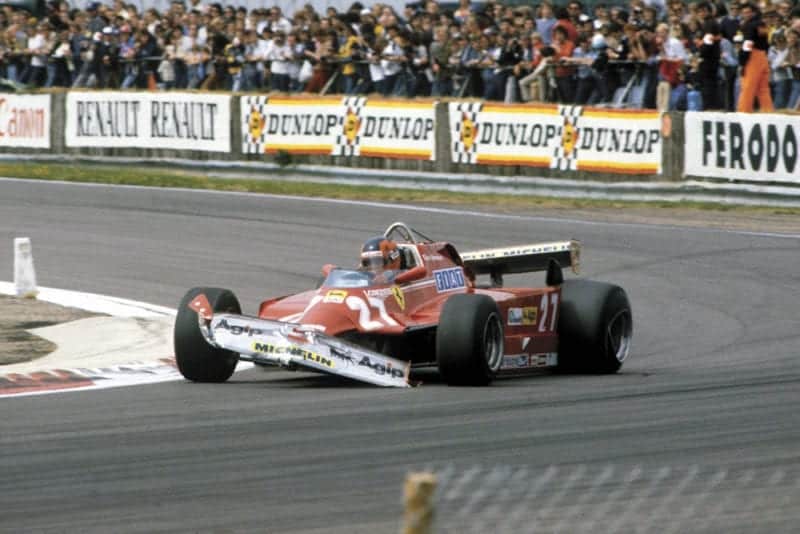
Gilles Villeneuve retired with a damaged Ferrari 126CK.
© Motorsport Images
Both practice days were grey and cool with the occasional sprinkling of rain, but luckily it did not affect the outcome at all and race day, which was Saturday July 18th, was warm and dry. The British Grand Prix is undoubtedly the biggest motor sporting event of the year in Great Britain and though it cost spectators a small fortune to attend they cannot complain of lack of ejitertainment, especially on race day. For three hours in the early morning there were coach trips around the circuit, then there was an hour and half to walk about in the pits, for those prepared to pay extra. At 10 a.m. there was a 20-Iap Formula 3 race, rather spoilt because practice which was in two parts had had one session in the dry and the other in the wet, so that some drivers were not as well placed as they should have been. At 11 a.m. there was a 20-lap Saloon car race and this was followed by a parade of the winning cars from the previous day’s race for sports/racing cars of the sixties. Just after midday the Formula One cars appeared for their half-hour warm-up session and then there was a long lunch period, during which there were parades, air demonstrations, superkart demonstrations and a surfeit of eating and drinking. At 3 p.m. the Grand Prix took place and when that was over there was a 12-lap race for historic cars. After that, if you were in a car, you joined the queue to get out, or if you were in a helicopter you rose vertically above it all, or if you were on a motorcycle you wiggled your way between the cars in the traffic jam and disappeared down the Buckinghamshire lanes. It was a busy day.
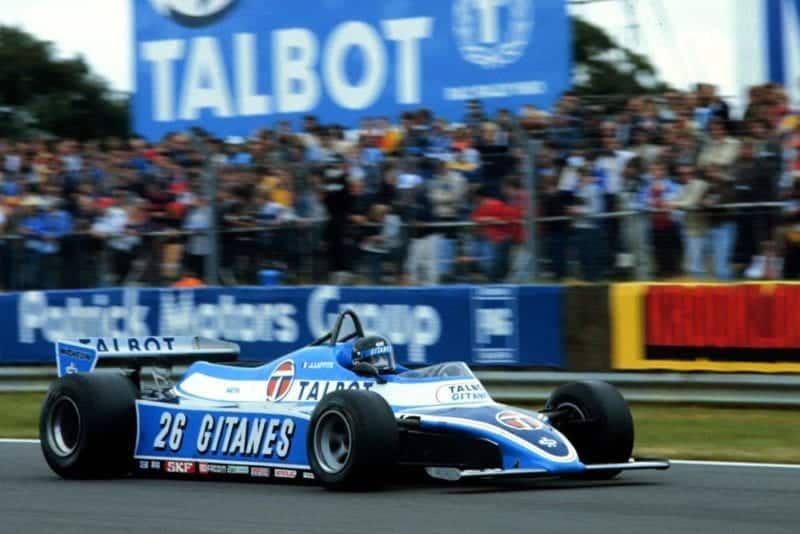
Third placed Jacques Laffite.
© Motorsport Images
Those who were lucky enough to have been at Silverstone on Thursday, and there were 9,500 of them, would have seen the Lotus 88B cars and the Tyrrell 011, while the 21,500 who were there on Friday saw Arnoux take the turbo-charged Renault round at an average speed of over 148 m.p.h. His pole-position time of 1 min. 11.00 sec. was 148.664 m.p.h., while Prost’s best was 148.568 m.p.h. They were recording around 130 m.p.h. out of Club Corner, and 170 m.p.h. at Abbey Curve; 140 m.p.h. past the pits out of the chicane and over 120 m.p.h. out of Copse Corner. Many people at Silverstone in 1981 were there in 1953 when Farina in the 4 1/2-litre Ferrari Thin Wall Special recorded Silverstone’s first 100 m.p.h. lap, long before the Woodcote chicane.
The race-day warm-up for the Grand Prix cars allows time for a final run on full petrol tanks, with race-duration tyres and gives a good indication of what might be about to happen. Ferrari abandoned their experimental car. Cheever was committed to his Tyrrell 010, Surer was in the new Theodore, Andretti had his Alfa Romeo engine fail, and de Cesaris spun off in the McLaren MP4/1 wiping off the aerofoils front and rear. Piquet was using the carbon-fibre brake discs on BT49C/11 for the first time in a race, and was obviously well in with a chance against the turbo-cars. The BT50/BMW was on display behind the pits, unfortunately with the engine covered up, and Silverstone was pretty well packed to capacity for what looked like being a good race. While the Alfa Romeo mechanics changed the engine in Andretti’s car and the McLaren mechanics dusted off the car of de Cesaris, all the drivers and teams were given two very important warnings. One was that the race would run for 68 laps, come hell or high water, rain or shine, storm or tempest, and the other was that in the case of accidents and yellow flags anyone seen overtaking under the yellow flags would be hauled into the pits very smartly by use of the regulation black flag and racing number of the culprit. It was all very straightforward and very clear.

Carlos Reutemann driving a Williams FW07C-Ford Cosworth.
© Motorsport Images
Right on time the twenty-four Formula One cars left the pits and went round to the form-up grid, everyone being in good order and ready to go with Piquet and Pironi ready to “jump” the Renaults if they hesitated at the start, while Jones and Villeneuve would be sure not to miss any opportunities once the green light had come on. Arnoux led them all round on the parade lap. They formed up on the grid, the red light was on, then the green and they were away amidst the wonderful noise that only twenty-four engines pushing out 500 plus b.h.p. each can make. It was Pironi that got between the Renaults, with Piquet close behind, followed by Villeneuve as they appeared out of Copse and streamed away up to Maggots Curve and Becketts. Twenty-three cars went by and then Alboreto appeared going slowly with the clutch of his Tyrrell slipping madly. Before the end of the lap Stohr had crashed his Arrows, so as the race ended lap one we were already down to 22 cars. Not a good start to the 68-lap race. Villeneuve was briefly past Arnoux on lap 1, so the order was Prost (Renault), Pironi (Ferrari), Villeneuve (Ferrari) and Arnoux (Renault). Turbo-charged cars in the first four places. Piquet was leading the rest and driving really hard, followed by Jones, Watson and de Cesaris. The lead that Prost had was already staggering and by the end of lap 2 it was almost unreal, he was just running away from everyone and with total ease. Arnoux had gathered himself up and snatched back his third place from Villeneuve and was hard after the other Ferrari, which he passed on lap 3. It now seemed to be all over, the two Renaults were in full command and leaving the rest behind, and making it all look very easy, but Piquet was fighting hard, passing Villeneuve on lap 3 and Jones was really leaning on the Canadian as they went into Maggots on lap 4, but just failing to get by.
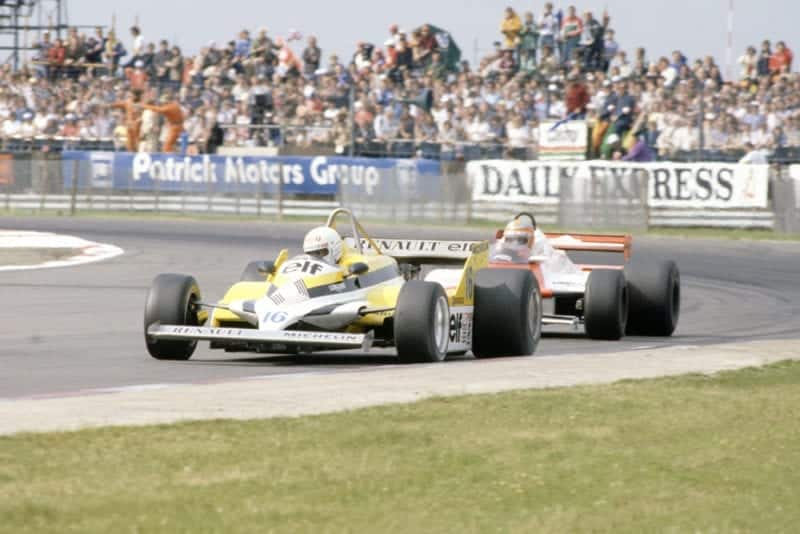
Rene Arnoux (Renault RE30) leads John Watson (McLaren MP4/1-Ford Cosworth).
© Motorsport Images
As they powered through the Woodcote chicane to end lap 4 Villeneuve’s Ferrari hit the kerb with a rear wheel, which put it into a full-lock slide, but then its hard suspension made it bounce on its soft tyres and then it was spinning in a cloud of rubber smoke. In the confusion the closely following Williams of Alan Jones hit the Ferrari fair and square as they skated into the catch-fencing, while John Watson stood on the brakes and prayed. His prayers were answered for he came to a virtual stop without hitting anything, but poor de Cesaris had little option but to dodge to the left, and that spun him into the retaining wall with a thump. Reutemann, Andretti, Giacomelli, Tambay and Laffite all went by Watson as he was regaining his breath, so that he dropped from seventh place to tenth. Jones and de Cesaris got out of their cars at once and ended their race, but Villeneuve, who had kept his engine running during the accident, rejoined the track after everyone had gone by and tried to get the Ferrari back to the pits ” … because you never know, it might be possible to mend it and go on racing …”. It expired at Stowe Corner. On the very next lap Giacomelli’s Alfa Romeo died with gearbox trouble so with only five laps gone the field was down to eighteen cars, and of those Daly was already two laps behind after coming into the pits on lap 2 with gear-lever linkage trouble.
At 6 laps order was regained, with the two Renaults sailing round in the lead and Piquet driving his heart out to keep them in sight. Pironi was fourth, Reutemann fifth, Andretti sixth and Watson already back to seventh place, the McLaren MP4 disposing of the two Talbot-Matras with consummate ease. Following came Rebaque, Patrese, de Angelis, Rosberg, Cheever, Borgudd, Jarier and Surer, with Daly a long way back but now going really well.
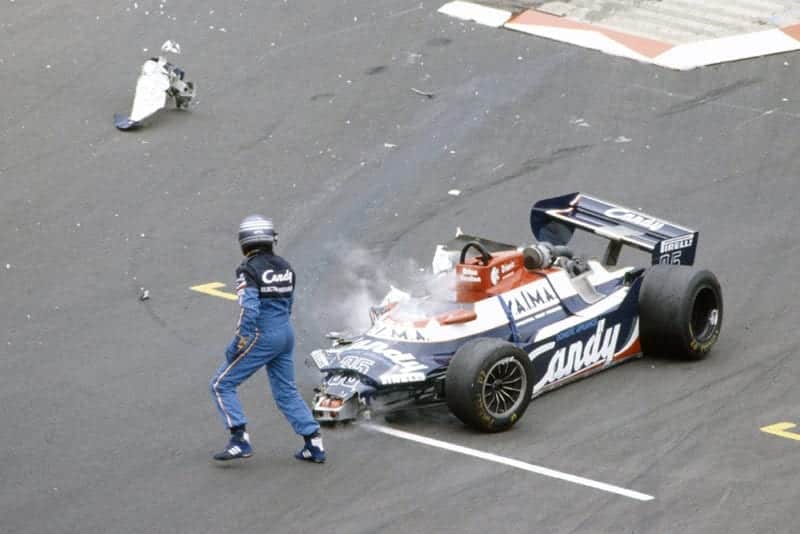
Brian Henton (Toleman TG181-Hart), did not qualify after this accident.
© Motorsport Images
The troublesome opening phase was obviously going to continue for Tambay’s Matra V12 suddenly went flat and he was into the pits for a change of plugs and then on lap 12 as Piquet approached Beckett’s the front left tyre deflated on the Brabham and the car careered straight on into the barriers. Piquet was extricated by the marshals and removed by ambulance with suspected leg and/or ankle injuries, but while this was going on de Angelis overtook Laffite and nearly collected the ambulance in so doing, so it was no surprise that he was very soon given the black flag. He stormed into the pits and disappeared from the scene pretty smartly, not waiting to be told what a naughty boy he had been. While this was going on Pironi’s Ferrari expired in a cloud of smoke and Watson, having passed Reutemann to great cheers from the crowd, suddenly inherited third place, to an enormous roar of approval fom the crowd. Tambay disappeared with a very flat-sounding engine and then a great stir went through the crowd, for Prost was into the pits with his turbo-charged V6 engine off-song. Nothing could be done, either the ignition or the injection timing had gone awry, so the car was retired. Only seventeen laps had been run and the whole scene had changed, Arnoux was in the lead, Watson was second, but a long way back, followed by Reutemann and Andretti. So soon and the top aces had gone out, Piquet, Jones, Villeneuve and Prost, while Patrese and Laffite were simply not keeping up the pace.
Not surprisingly, after so much excitement and turmoil the whole scene settled down with Arnoux majestically in the lead, Watson in a tenuous second place for Reutemann was not far behind in third place and no-one knows what goes on in the great Argentinian’s mind when he is racing. Andretti was a lonely fourth, followed by Patrese, Rebaque, Laffite, Cheever, Surer, Borgudd, Rosberg and Daly. A long way back after a pit stop to reset the rear aerofoil on the Osella was Jarier. For many laps nothing happened, the cars circulated regularly with the gaps between them gradually widening, and Arnoux lapping the tail enders.
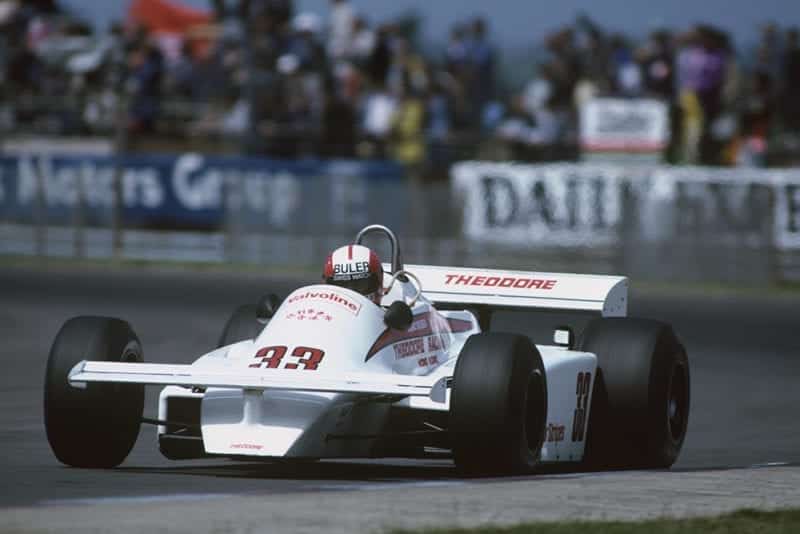
Marc Surer at the wheel of a Theodore TY01-Ford.
© Motorsport Images
Rebaque stopped for a tyre change, which dropped him to the back of the field and Patrese eventually caught and passed Andretti, but it was hardly significant. Surer was having a real go in the Theodore to catch Cheever, and Daly was still going exceptionally well in the new March, but handicapped by his long pit-stop. For lap after lap the leaders droned round becoming more and more spaced out, with onIy Watson, Reutemann and Patrese now on the same lap as Arnoux. The sunshine was warm and the whole scene peaceful and tranquil and few people noticed Rebaque go into the pits for another tyre change. The laps ticked by and it was obviously going to be a rather dull Renault walk-over, with victory for Arnoux. On lap 50 he recorded his best race lap in a leisurely 1 min. 15.067 sec., if you can call 140.6 m.p.h. leisurely, but on lap 51 everyone sat up and a roar came from the crowd. The Renault exhaust note suddenly lost its edge and two laps later the yellow, white and black car was slowing visibly. The crowd rose and cheered Watson on to greater effort to catch the ailing Renault, to which he responded magnificently. By lap 57 he had the Renault in sight, but Arnoux was not giving up in spite of feeling totally depressed. He was really scratching round the corners, but it was all over for him, the McLaren simply gobbled up the gap and as they went away on lap 61 Watson was alongside and the cheers from the crowd said it all. “Wattie” was in the lead on lap 61, with only seven to go and the designer of the MP4, John Barnard, with his two assistants headed back to the pits from Copse Corner looking remarkably cool outwardly, but no doubt elated within. Poor little Rene Arnoux was desperately nursing his sick Renault along in second place, but as he started his sixty-fifth lap, with only three to go, the engine gave up the ghost and he pulled off at Copse. A malfunctioning in the injection system had upset the mixture and some vital part inside the engine had cried “enough”. While everyone was jubilant to see John Watson ease home the winner, real sympathy went out for Rene Arnoux.
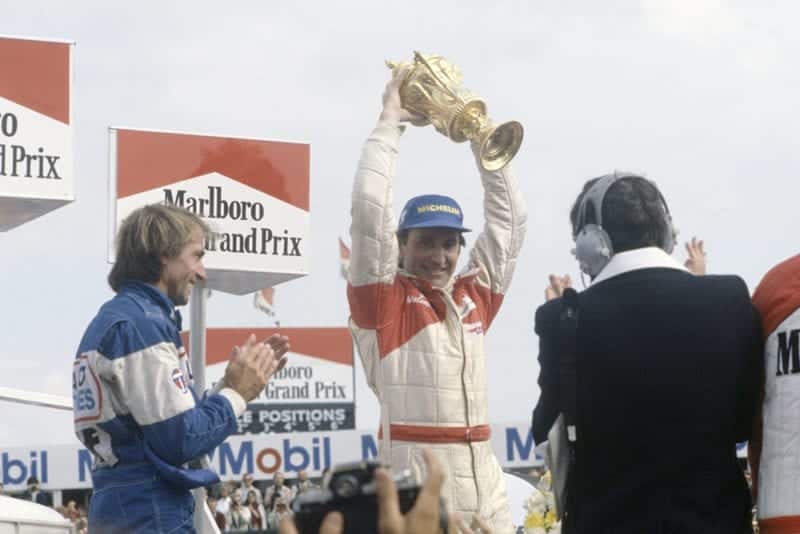
John Watson, 1st position and Jacques Laffite, 3rd position on the podium.
© Motorsport Images
This left Reutemann second and Patrese third, but only a lap after the Renault went out the Arrows engine gave up and Patrese was out, so that as the chequered flag began to be unfurled Laffite, who was a lap behind, found himself in third place for Andretti had stopped when a clevis pin fell out of the rear end of the throttle cable on the Alfa Romeo, and within sight of the finish Marc Surer was forced out when the Theodore lost all its fuel pressure. Almost unrealised Cheever nearly caught Laffite as they crossed the finishing line, both a lap behind Watson, so moved was everybody to see Watson win the British Grand Prix. The enthusiasm of the crowd all round the circuit was memorable, not exactly rivalling the Itallans when a Ferrari wins at Monza, but nonetheless a splendid display of enthusiasm for a truly British victory. Marlboro were delighted as they not only sponsored the race but they sponsor the McLaren team as well. It was indeed a popular win. – D.S.J.
[We are pleased to hear that the injuries sustained by Piquet are less serious than originally thought and amount to no more than serious bruising. Ed.]
